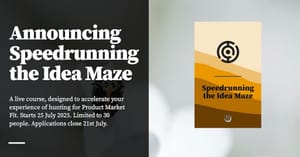Note: this was the final issue of the Commonplace newsletter in 2022, sent to subscribers on 29 December.
As time passes, it’s become increasingly clear to me that my twin obsessions on Commoncog are about a) becoming a better business operator, and b) about the accelerated expertise approaches that can help us get there faster. That’s a sizeable leap for a blog that started out obsessed with ‘career moats’; I’ve mostly left that behind for my lifelong obsession with execution excellence in business.
Of course, ‘making better career and business decisions’ is a crisper way of capturing these twin obsessions, but in many ways the method with which you get better at making good decisions is to gain expertise in the domains you’re interested in. I don’t mean to say that these are just the two topics that I’m going to talk about — there will certainly be essays on career decision making that I’ll want to put to practice and explore — but by and large, Commoncog’s contribution to the world seems mostly around extremely pragmatic, extremely practice-oriented approaches to business and to gaining expertise in business.
I want to take this opportunity to take a look back at all the ideas we’ve explored together over the course of 2022, and to give you a taste of several ongoing experiments that I’ll write about in 2023. Some of these projects are things I’ve hinted at in previous issues of this newsletter. All of them, I hope, will be useful to you. And of course, I want to thank you for the support you’ve given me by either reading this newsletter every week, or by signing up and paying for a Commoncog membership in the past two years — I am constantly thinking of ways to giving more value … which we’ll get to later in this newsletter, I promise.
On to the recap:
Commoncog Recapped
The biggest topic that consumed my attention over the course of this year was the implications of Cognitive Flexibility Theory. If you’re new to this, I wrote a summary of CFT in my previous piece on Technological Windows:
CFT goes something like this: in ill-structured domains, concepts exist, but the way concepts show up are incredibly variable and highly context-dependent. Business, for instance, is an ill-structured domain — concepts like scale advantages and network effects are real things, but they look very different depending on the specific business, the specific industry, and the specific time period. In other words, if you want to get good at business you’re going to have to get used to the idea that whatever business problems you’ll face are going to be unique to your business, and application of business frameworks will be far messier — with far more variability — than you might have ever imagined.
CFT explains how experts in ill-structured domains recognise and use concepts when the real world situations they encounter are constantly novel. It tells us that what differentiates experienced businesspeople from less experienced businesspeople is the same thing that differentiates experienced doctors from less experienced doctors: experienced practitioners are not surprised when a particular concept (or medical ailment) shows up in a weird-ass way; they are able to diagnose and respond to concepts in practice because they know that reality is messier and cases are unique in a way that cannot be fully captured in business books (or medical textbooks). In fact, if you’ve ever encountered a situation in business where you say to yourself “crap, the best practices don’t work here”, or “I had no idea a competitor could beat us in this particular way, huh!”, you’ve probably experienced this in action.
Naturally, I was interested to see if it were possible to accelerate expertise in ill-structured domains. The entire series of blog posts that covered CFT and its implications may be found here. I recommend How Note Taking Can Help You Become an Expert if you’d like a readable summary of the theory, and how you might want to use it in your career. If you’re a member, a more rigorous (or academic, depending on how you look at it) summary may be found here.
CFT led to a number of interesting ideas. One essay that did particularly well was Don’t Read History for Lessons — which took the implications of CFT (how experts learn from cases) and applied it to the more general topic of how to read history. Another thing that fell out of my digging into CFT were two conversations with Rand Spiro, the lead researcher behind the theory: Dancing Landscapes in Business was Spiro’s articulation of the ill-structuredness of business, taken from an illustration in complexity theory. And Focus on the Cases (members-only) was Spiro’s articulation of the importance of case-based reasoning over framework-based reasoning in business.
Finally, my deep dive into CFT led to the creation of the Commoncog Case Library. I’m still iterating on the right ‘shape’ of the library (as I mentioned in last week’s blog post), but I’d like to thank all of you who participated — whether you did so in the Alpha, or the Beta. You should see more improvements and experiments in the new year.
If we look outside of CFT, I covered a number of ideas that have proven rather popular with readers:
- The highest impact thing we worked on this year was probably the Commoncog Burnout Guide, which Guan Jie Fung and I published in July this year, after months of research. Multiple readers have said that the Burnout guide has been a huge help to them, especially in the wake of pandemic-induced burnout.
- I wrote a short series about incentives, and how studying incentives in an industry can help you navigate building products for and selling products into players in said industry. I told the story of how my old boss and I worked out — over the course of a number of years — the incentives of the F&B industry, and how that informed the approach we used to sell Point of Sales Systems to them. The second entry in the series (Pay Attention to Deviations from Mainstream Incentives) ended up on the front page of Hacker News.
- I’m quite proud of the synthesised model in What Good, Cash Strapped Hiring Looks Like — a few readers told me that they’d independently settled on a similar approach to hiring in their respective companies, which was the whole point of the essay.
- Putting Amazon’s PR/FAQ to Practice is exactly what it says on the tin, and was the result of nine months of repeated stabs at the technique. Tim Bray recommends it. My one sentence pitch is that this is an outsider’s attempt to put the PR/FAQ to practice, albeit with the help of Colin Bryar (who was there for the birth of the technique); much of the descriptions of Amazon’s PR/FAQ process are written by insiders, who are verifiable experts at it. My hope is that this essay helps you implement the PR/FAQ in your own organisation.
- Be Good to Your Mentors takes a common sense definition of mentorship (“a mentor is just someone who answers questions more than once”) and then runs with it. It asks: “how do you continue to earn the right to ask questions?”
- On the business strategy front, we covered Cultural Advantage is Counter Positioning, the result of a remark that Hamilton Helmer made on a podcast; What Danny Meyer Did — a look at several concept instantiations from restauranteur Danny Meyer’s autobiography; finally, I presented members with a business puzzle in Is This a Moat: Mailchimp and PayPal’s Algorithmic Advantage.
- On the expertise front, we talked about how Ability to See Expertise is a Milestone Worth Aiming For, and then the difficulty of Verifying the Believability of an expert when you’re canvassing for advice.
Upcoming Essays
One of the difficult things about Commoncog is that I write from practice. Sometimes essays takes months to write, because experiments take months to execute. The PR/FAQ piece I linked to above, for instance, took about nine months of work … because all my earlier attempts at writing PR/FAQs failed miserably.
I’ve hinted at a number of experiments that are ongoing, but I want to give you a preview here, so you know what’s coming down the pipeline next year:
How do You Actually Become a Data Informed Company?
Early in 2022, Colin Bryar (one of the two authors of Working Backwards) reached out to discuss a project on making the Amazon-style Weekly Business Review more accessible to external companies. For the uninitiated, every Wednesday morning, Amazon’s leadership goes through 400-500 metrics in 60-90 minutes, in order to develop fingertip-feel for the entire business. How they do this is the result of a multi-year trial and error process. Bryar and Carr dedicated an entire chapter in Working Backwards to the practice, but have since learnt that implementing the WBR in an external company is more complicated and involves more things than the book chapter can cover! Bryar asked me to help them write a series of tutorials on implementing a WBR from scratch; I also had to write some code to generate data for a series of sample decks.
I agreed to the project for two reasons: first I wanted to learn what it mean to be data driven (or to run a data-informed company), and I wanted to learn about the stories behind the WBR process. I’m happy to say that the project is completed now, though not yet released — I can’t write publicly about my learnings until the code and the tutorials are publicly available on their website.
That should happen sometime next year.
Over the course of the project, though, I learnt that many of the ideas that informed the WBR came from the field of Statistical Process Control. Bryar himself calls the WBR a ‘process control tool’, and argues that it may be applied to any business process that you want to control (that is, improve). That, plus a throwaway reference to Donald Wheeler’s Understanding Variation, led me down a rabbit hole on Wheeler’s and Deming’s ideas, which in turn showed up in a series of articles late in the year: You Aren’t Learning If You Don’t Close The Loops, Process Improvement is Trickier Than You Think, and The Disaffected PhD Skunkworks: A Story About Process Improvement.
Based on my work on the WBR tutorials, and on multiple conversations with Colin over a series of months, my current suspicion is that Amazon was the first major software company to have successfully applied ideas from statistical process control to software development and to the business of software more generally. Digging into this vein should yield a series of useful ideas.
What is Deliberate Practice Actually Like?
About a month ago I relocated to the capital of Malaysia to train for the Malaysian Senior Judo Nationals. I train Judo four hours a day, and have basically cut out everything else from my life for a period of three months. The Nationals are in March. That leaves me with about two months left to train. I’ll be spending a huge amount of time on Judo until then; other Commoncog experiments are going to be slower than normal.
(I’m afraid that I can’t meet up, even if you’re in town; the training volume I’m doing is serious enough that I need to prioritise rest and recovery adequately. Most of my friends don’t even know that I’m here).
I’m doing this for a handful of reasons, which I’ll go into when I write about the experience. The most important reason is that this is an experiment: how far can I accelerate skill development if I take it seriously for an extended period? What does deliberate practice actually feel like when you’re doing it? I’ve written about how most of us can’t benefit from the findings of deliberate practice research in our careers, because you can’t really do DP if you do not have well developed pedagogical approaches for the skills you want to work on. Most careers don’t have good pedagogical development — try finding a series of exercises for getting better at office politics, for instance! — but Judo is a sport, one that I love, and it has a well developed pedagogical approach, albeit one that isn’t well known in South East Asia. So what happens if I threw myself at it under a willing coach?
You should expect a longer piece in a few weeks. Suffice to say, this experiment is tough on my body; I nurse sore fingers and stubbed toes most days of the week. But perhaps the most surprising thing for me is that I find the mental aspects of training far tougher. A small anecdote: two days ago I did a gripping drill with a heavier, stronger player, and he accidentally smashed his arm into my face during the drill. I fell to the ground and spat out a small, chipped portion of my tooth. And then I had to go back to the gripping drill, fighting off pain and nausea.
The next day I was hesitant during free sparring, fearful of the grip fight. I got chewed out by my coach. He told me to blank my mind: “Just blank it out. Don’t think about anything. Your head is empty! You are not affected. You need to have a good session.” And it worked.
(I also have a dental appointment on Saturday, so don’t you worry about that.)
I have more anecdotes like this. I’ll save it for the essay.
Chinese Businessmen: Why Are Most Companies in Asia Conglomerates?
One of the topics that I’ve been sitting on for a bit now is a continuation of my Chinese Businessmen Series. (If you’d like something of the same flavour, you might enjoy the Incentive Series, or perhaps the Koufu case study that we released as part of the Commoncog Case Library; both deal with quintessentially Chinese business contexts).
The short preview here is that I’ve continued digging into some of the questions that I left unanswered at the end of the series, and have been doing so for the good part of two years. One of the related questions that I’ve left unanswered (though perhaps hinted at over numerous Commoncog essays over the years) is the question: “why are most companies in Asia … conglomerates?”. This has more practical implications than you might think: if you run a small business or a startup in South East Asia, odds are pretty good that you’ll eventually bump up against one of these major conglomerates over your years of doing business. And then either they offer to do a joint venture with you (they’re always angling for JVs, for some very good reasons that are too long to get into here), or they buy a small equity stake to watch you, or the families that control these conglomerates turn out to be LPs in the venture funds who do.
Why this is the case, and why the capital structure in Asia generally lends itself towards conglomeration is a Big Idea type of topic, one that Commoncog doesn’t typically cover. But I can’t seem to help myself in pursuing the question. I have a handful of answers now, ones that I’ve run past people who were involved in such Asian conglomerates. One caveat is that I’m not particularly sure I have the right answers (much less the politically correct ones) — so perhaps I have to publish my writing on this behind a paywall, for members only. But with all that said, I hope to tackle this topic in the coming year.
Thank You
If you’re reading this, you’re probably either a Commoncog member or a Commonplace newsletter reader. If you’re a member, I want to thank you for your membership — the experiments that I run and the ‘research’ (if you could call ‘putting business ideas to practice’ that!) are all possible due to your support.
If you’re a Commonplace newsletter reader, and you’re not a member, I’d also like to thank you for letting me into your inbox, and by extension into your life. Thank you for reading, and thank you for sharing articles with your friends. I hope I’ve been of some use to you.
One of the challenges I’ll have to confront in the new year is that there is a time limit on writing from practice. At some point I’ll have to transition to more ‘doing’ than ‘writing’; my hope is that the Commoncog Case Library will be able to accelerate your business expertise in a way that doesn’t require me to continue running experiments that fit into the typical cadence of a blog publishing schedule. If that succeeds, Commoncog will become a repository for concept instantiations; I’ll be able to focus on growing the business for a bit. And then maybe return to writing about business topics when the lessons are ready.
This is a long newsletter; as always I hope it finds you safe, sane, and healthy.
I’ll see you next year.
Warmly,
Cedric
Originally published , last updated .





